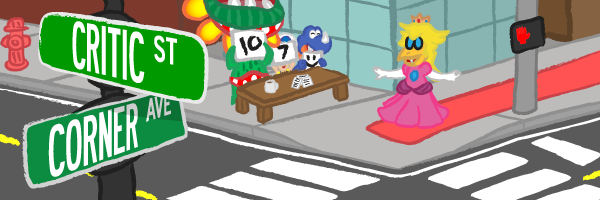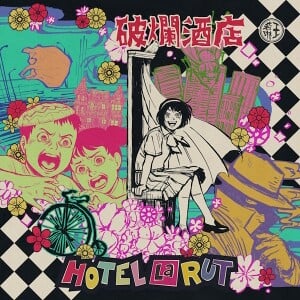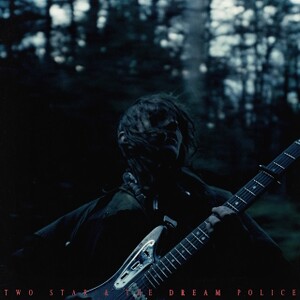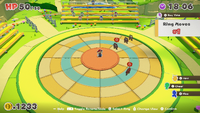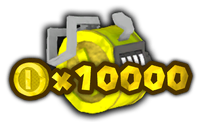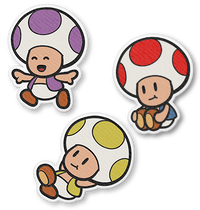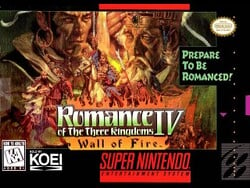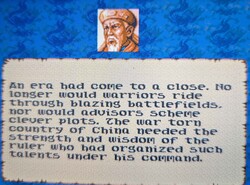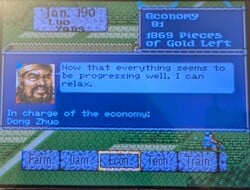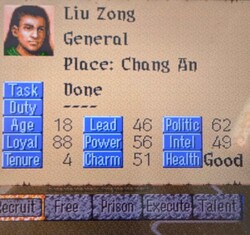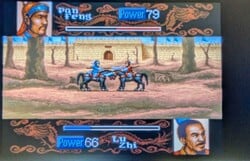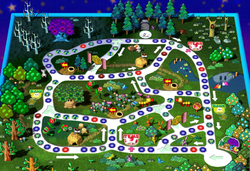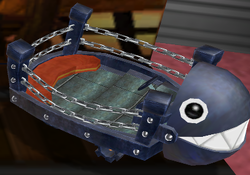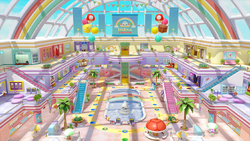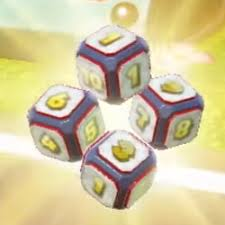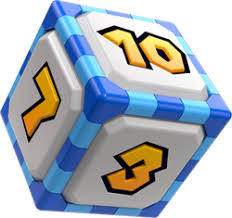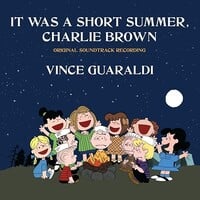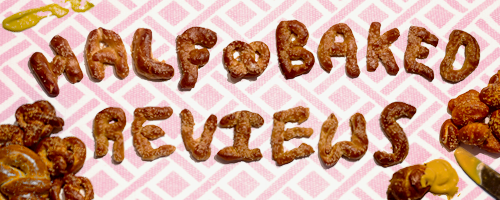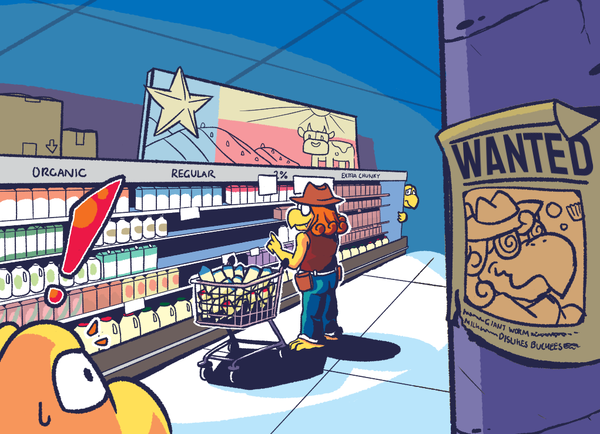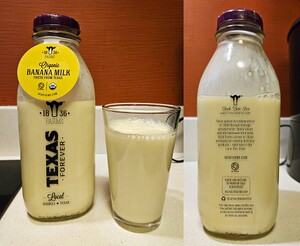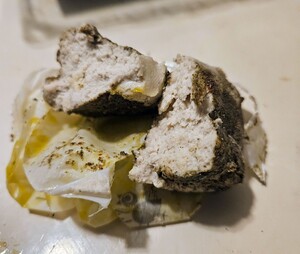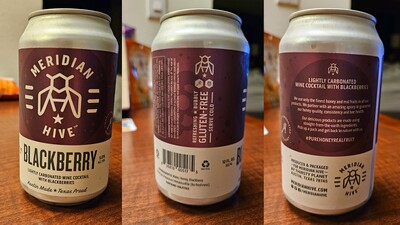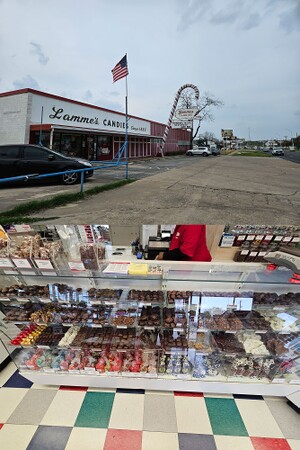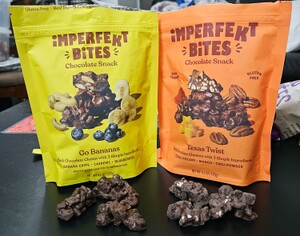The 'Shroom:Issue 210/Critic Corner
Director's Notes
Welcome to September! We're now in the -ber months which means it's time for things to get crazy again. School, work, politics, home, everything, so find those moments of peace here at Critic Corner where you can read even more opinions and hopefully be relieved at having our writers say such good things that you agree with, right? Right?? Well this month, along with our usual sections, we have a spectacular amount of new sections: Paper Plumm (talk) with A Paper Mario: The Origami King Gameplay Review, Fizzle with Life of the Party, Waluigi Time (talk) with The Peanuts Sessions, and Shoey (talk) back with a Shoey's Shoetacular Reviews, so kick those shoes off and relax.
Thank you for voting Half-Baked Reviews as August's Critic Corner Section of the Month!! Be sure to give your love to all of our sections here, and give a shout out to our writers whether in chat or in their forum threads dedicated to their sections. Be sure to vote vote vote!
And now for my regular announcements: We've decided to implement in Critic Corner something similar to News Flush over in Fake News, where no formal sign-up application process is required for one-time or limited sections. From now on if you just want to send in a single review for something you just read, watched played, tried, whatever, you just have to send me your review privately either to me directly in chat, or in a message to me on the forum at least one week before each 'Shroom is to be released! There's no commitment or obligation to provide a full monthly section (although you absolutely can shift it into one if you so choose), just send us your thoughts on a thing and we'll feature it here! If you have any questions or curiosities about this, please feel free to ask!
As always, if you would like to help Critic Corner, we always have openings for more writers! You are free to write for sections such as Character Review and Movie Review, or really anything you'd like to do! There's no pressure to have a huge section; they can be shorter and concise! The application process is very simple, starting with reading the Sign Up page, and sending your application to Meta Knight on the forum. Any idea you have is welcome, and if you have any questions or need help signing up, please feel free to reach out to myself or other 'Shroom peeps!
Section of the Month
| CRITIC CORNER SECTION OF THE MONTH | ||||
|---|---|---|---|---|
| Place | Section | Votes | % | Writer |
| 1st | Anton's Half-Baked Reviews | 13 | 59.09% | Hypnotoad (talk) |
| 2nd | A Paper Mario: The Origami King Review | 9 | 40.91% | Paper Plumm (talk) |
'Shroom FM
Hello to you all! You may remember this section was missing for the past two months, but don't worry. I forgive you if you don't.
I have been listening to a fair bit of music over the summer so I thought it'd be best to just throw everything together into a little summary of what I've enjoyed and what I haven't. This isn't going to become a regular thing unless I am too busy to submit in October and November. And then it wouldn't really be regular anyway.
I listened to Night Reign by Arooj Aftab during a 3-hour train journey one evening in June, and it just clicked so well. Stylistically it's a perfect blend between chamber folk and jazz, though seamlessly explores and incorporates a number of different styles while balancing the two. Gorgeous production and such a vivid, dusky atmosphere that's so rewarding to sink right into.
Another brilliant album for a summer evening is Passage du Desir by Johnny Blue Skies. This is an alter-ego of Sturgill Simpson, whose other work I've never explored before, so I can't say as to how much this differs from his usual style. There's some really amazing songs here and so much that clicked with me - from the emotionally heavy stuff like "Jupiter’s Faerie" to the comparatively straightforward "Scooter Blues". Lyrics are well-written too, often very bittersweet.
Fontaines D.C.'s Romance - like its predecessor Skinty Fia - is full of bangers. I will admit that "Starbuster" did take me a couple of listens to fully warm up to but I am all for it now - super energetic and catchy, in just the right amount of your face; the highlight by far for me are the sharp intakes of breath. The real gem here though - and the best choice of song to close the album with - is "Favourite". The whole song flows on tremendously, held together by the brilliant, jangly guitar riff. Feels a lot like late '80s indie/jangle pop (c.f. C86), so it just clicked instantly for me. I can't go on about every song on the album but "Desire"'s slow, moody build to its soaring conclusion, and "Bug", another brilliant straightforward indie rock track, also stood out for me.
Magdalena Bay's Imaginal Disk was probably one of my most anticipated albums of the year - while their debut in 2021 was good, it's never really clicked with me as much as I'd hoped it would; everything they've released since has just been progressively better and better. 'Death & Romance', the first single, blew me away when I first listened to it - but 'Image' is my favourite song of the entire year, so far. The surreal imagery in the lyrics and vivid soundscape are one thing, but the chorus is phenomenal - particularly right at the end when the extra synth bass line comes in under it. There's a lot of inspiration from the early internet age in the late 90s which gels well with the concept behind this - hard to explain in brief but at some point involves a disc being inserted into the head - and the bright synths. It's really imaginative and creative, with a ton of depth and manages to effectively tell a story within songs that stand out just as well on their own.
Finally, the new Nala Sinephro album that just came out, Endlessness, might be my favourite out of all of these. A sublimely crafted electronic jazz album; the way it moves and flows, and the soundscapes she explores here, are immense - particularly the way the synths contrast and interact with the more traditional instruments.
You will be hard pressed to find a more fun and creative album this year than Joanna Wang's Hotel la Rut. There's 23 songs here crammed into 51 minutes here, many of which under two minutes in length. This is apparently based on a Kids in the Hall sketch (or multiple) and the concept is that each song explores different characters and situations within this hotel. There's a huge range of different styles, genres and moods going on here, and while some ideas aren't quite as well-developed as others, on the whole everything is executed really well. It's an album where it's hard to see anyone coming way with the exact same experience.
Dime precioso by Álex Anwandter is an absolutely stellar dance-pop album. Running at just over 31 minutes, it's quite short in comparison to last year's El diablo en el cuerpo which ran for over an hour, but there's still plenty of bangers packed into this. Wonderfully consistent, great synth and guitarwork, and a lot of fun.
Zach Bryan's The Great American Bar Scene is really well-written and engaging. Hadn't checked out any of his work prior to this but very much impressed, some lovely Americana soundscapes on here. I sure do wish America was real.
Finally, while I did listen to this crammed into a corner on a completely packed train over the course of an hour, Liana Flores' Flower of the Soul is a gorgeous folk album. Very light and soothing to listen to, yet still engaging.
I did nearly write off English Teacher as soon as I first heard of them - they do have one of the most generic 2020s UK indie band names I've ever heard - but This Could Be Texas is actually pretty good! A lot of it reminds me heavily of 90s indie rock; particularly Lily Fontaine's vocals, effortlessly cool and detached while still engaging. "I'm Not Crying, You're Crying" and "Nearly Daffodils" in particular are highlights for me. Unfortunately the momentum does run a bit dry by the end, exacerbated by "The Best Tears of Your Life" - which centres around a grating, bizarre hook, autotuned for some reason. Not good. Nothing else on the album sounds remotely like it, thank christ. The songs that follow it are fine but clearly there's not a lot of steam left by that point. Outside of that, this is a decent little record.
Speaking of good indie bands, Mannequin Pussy's I Got Heaven is a perfectly fine record. Never had too much interest in them before but plenty of decent songs and some satisfyingly loud moments.
Julie Christmas' Ridiculous and Full of Blood is cool. Nice and loud, very strong and chaotic vocal performance. "Supernatural" is especially good.
It took me a long time to check out The White Stripes because I'd always assumed I wouldn't like them, and for some reason now that I DO listen to the band it's never crossed my mind to check out any of Jack White's solo work. I gave NO NAME a listen and yeah, I get it. I see what he's up to. Really solid garage/blues rock, not a genre I've checked out much but so satisfying when it clicks.
We can't end this section yet. We haven't even talked about Hiatus Kaiyote or their album Love Heart Cheat Code. For a large chunk of the runtime, this is fairly standard for the band - psychedelic and lush neo-soul. "Longcat" is a cute song; weirdly it's not about the meme from nearly 20 years ago (yes, really) but a DIFFERENT long cat - even though it sounds exactly like a song someone would've uploaded about the earlier longcat onto YouTube in 2007. What I really should be talking about is "Cinnamon Temple" where the album takes a very hard left turn into noise rock with loud, fuzzy guitars and complex structures. It's unlike anything else I've heard from the band, completely bizarre and incredible. The album then ends with an even stranger cover of "White Rabbit", which sounds virtually nothing like the original. It's not amazing but I appreciate it for just how completely out-there and experimental it is.
Fat Dog put out some great singles in the run up to their album release, particularly "Running" which goes absolutely mad and has some of the best energy of anything I've heard this year. There's also a lot of hype around their live shows. So now their debut WOOF. has finally released, why does it feel like such a non-event? The singles I'd heard before were still good. The only one I hadn't was "I Am the King", which seems less well-received than the others. I can see why - to be frank, it's a two-and-a-half minute intro to a 20 second outro, a perfect anti-climax. But it's not bad enough on its own to drag the album down. "Clowns", on the other hand, is an abomination - weirdly for the exact same reason as that English Teacher song I hate. Horrendous-sounding, aimless autotuned vocals pasted over some 'epic' orchestral instrumental. I guess the main problem though is that it feels too short. It's nearly 40 minutes but comes and goes with surprisingly little fanfare.
Unfortunately, while there were some songs I really enjoyed, I didn't get much from Nia Archives' Silence Is Loud. Honestly I think the reason why I'm struggling with this is because her style of jungle/D&B is great - just feel like many of the songs here don't offer a great way to showcase it, and I felt exactly the same about her EP last year as well. I love the Columbo sample on "Forbidden Feelingz" though, what a guy.
New Porter Robinson album Smile! :D... it's fine. I was smiling more like :) than :D for most of it though. A strong opening half with "Cheerleader" is dense and energetic, "Russian Roulette" is fun, and "Perfect Pinterest Garden" is nice and bright. After that, the album sort of drops off. Robinson's style here is definitely honed but there's not really a lot going on that feels as exciting as his music should feel.
After two listens, I can confirm I do not like Two Star and the Dream Police by Mk.gee. I just really can't stand the guy's style, at all - the murkiness of the soundscape, the annoying effects on the vocals and the general wispiness of it all. It's hard to say anything about the songwriting because barely of it comes through under this, vocally it seems to me like the same thing just keeps happening again and again. For such a short album it definitely feels like it's oustayed its welcome at least three tracks before the end. It's trying so hard to be ""lo-fi"" that it just comes across as completely forced and artificial.
I also didn't like Early Twenties by Cat Burns. She's taken off a fair bit in the UK recently. Vocal performance is fine, production is nothing special but not bad - unfortunately, the songwriting here is plain weak, and it's far too long. Nothing at all that stands out during the whole runtime. We have moved past the need for songs called "Live More & Love More". It's worse than the Mk.gee album but for some reason it annoys me less.
A Paper Mario: The Origami King Gameplay Review
Written by: Paper Plumm (talk)
Hello Yello and welcome back to another review portion. I realise I kinda poorly worded my title last time. This is not one review, this is four reviews for four different parts of the game. Today we will be discussing the game's gameplay. This includes its battle system, overworld gameplay and minigames.
Battles!
The Origami King's battle system is one of its most hotly contested elements. Just as many people are its prosecution as its defence. The game employs a ring based system for battles. This is why this system is as divisive as it is. It inherently hinges itself on one thing, do you like sliding puzzles? I hate sliding puzzles. I used to struggle to solve even the most rudimentary of these types of puzzles. However, Origami King is exceedingly kind in this regard. It continuously builds its pace of complexity for its puzzles at a rate that allows even someone likely to struggle with this to slowly ease into sliding puzzles and their complexity. The game also provides a timer extension and Toad assist which are helpful, though costly, and don't hinder the experience for more hardcore battlers.
The system provides a massive amount of flexibility with its concepts, one rarely finds themselves doing the same thing over and over. Enemies, meanwhile, leave a bit more to be desired. Most enemies are the same with no unique gimmicks of the sort to them. The only individual distinct enemy variety that comes to mind is the Lil' Cutout Soldiers. These are enjoyable through requiring being folded together before being fought. The only other variety is a disappearing enemy variety in the form of Origami Boos, and Piranha Plants who disappear during the puzzle portion. I really like these unique enemy types but, I can't really think of other concepts they could have done with the enemies themselves. Bosses, meanwhile, are a very different story.
Every boss in this game is fresh or unique in some way, expounding on an already great regular battle system. The boss battle system, while still requiring sliding puzzle solving, creates a unique formula for it, requiring not for the enemies to come to you, but you to come to the enemies. The way the game provides a large amount of things on the game board for one to try to make a path through and to combat is really clever. It creates some compelling strategies for the path to the boss, and to top it off, each boss provides unique gimmicks to make each battle a bigger challenge. Some of my favourite gimmicks include Jean Pierre Coloured Pencils the 12th's gimmick of danger spots to avoid, Fire Vellumental making its parts disposable and danger spots with the player having to maximise the damage from deadly fiery feather spots and extinguish the Fire Vellumental when the danger is at its apex (easily my favourite boss battle), Ice Vellumental creating Ice Patches and even some mazes, Tape sticking together certain sections making them move together, and Scissors who is a one hit K.O. (Side note: While researching for this review I looked at the Legion member's titles in other languages and some of them were absolutely hysterical. Some of my favourites include KLaudius KLementinus KLeurpotloden XII, the Dutch name for Jean-Pierre; The Triumphant Adhesion Maniac, the Korean name for the Shifty Sticker; and A Biting Enemy, the Italian name for the Fanged Fastener. Tragically, Scissors' Dutch title is missing. So I will make a formal bounty now. Anyone who is able to find and add the missing title will be credited in the next part. And I go above and beyond with credentials.)
Partners in this game don't really mesh well with the game's battle system. Partners are excellent additions, greatly enhancing the overall story but due to the strong desire for battle partners, they seem to have been tacked on to the overall system. Items are here as well, and like partners, seem tacked on for the sake of items. I'd say this is a sudden issue, but I can't think of the last time I used a non-healing item in any Paper Mario game, much less this one.
Less disposable weapons are back as well. I say less disposable as they now break after many uses, not one. This is another element I don't think was really necessary to add, it just ends up becoming an annoyance to have to keep buying pricey weapons to just stay on the same level as enemies. I find it interesting how most of the new elements work really well with this system, but the more desirable aspects of the classic games' battle system fail. This is really unfortunate, as like I suggested in my last part, this seems to be this style of battle system's last hurrah, so to see them finally give in and add in older elements against the battle design's better judgement is really unfortunate.
A big issue of the two previous battle systems was the lack of motivation to utilise them. Paint and stickers were not really that necessary as a reward for their systems. Origami King, meanwhile, rewards coins and confetti. Confetti has a very steep decline in usefulness. Near the beginning, it feels like a very limited resource in which battles are one of the few reliable methods to hold onto it. In fact, Overlook Tower even forces the player to drain their confetti supplies in the enemyless environment, causing them to rely on a linear series of methods to progress up the tower. As soon as this is over, however, the game offers confetti upgrades to celebrate each chapter's end. This very quickly makes confetti lose any sense of limitability, as following this, confetti can easily be stored in surplus without a need for battling.
Coins are a bit more iffy. If one is playing the game in a normal fashion, battling will be very pointless as the game shoves coins down your throat every five seconds. If one is more completion oriented, (I strongly recommend this playstyle) the insane wallet size will be countered by the insane prices of this game.Overall, I think this is a pretty great system. It is definitely not many people's cup of tea, so I can understand those who hate it. This system, while not perfect, still manages to constantly feel fresh and challenging. I can not tell enough how often I find myself dragged into a monotonous cycle with classic Paper Mario battles. The games don't really reward complex strategies so I feel encouraged to stick with the same few strategies. Bosses in those games don't really require drastic changes or barely ever add new gimmicks to the overall battle experience. I'll be frank, I think Origami has a better system than the classic battle system. I know, this is a crime against humanity, but please calm down and don't lose your mind if someone has a different opinion than yours. There is enough room for modern fans like me, hardcore classic, and even Sticker Star fans. Be civil towards mine, and I'll be civil towards your opinion. Classic Paper Mario to me feels like a very safe battle system while this is a more ambitious and risky system. Every battle forces a new perspective and examination of its puzzle. Its bosses are excellently done and are, as any good boss should be, a highlight. They have their own battle system to stand out, and each provides new gimmicks that provide rewarding opportunities for clever strategies. It certainly has its flaws, but none of them are anything game breaking and can easily be ignored. Despite my original hatred of sliding puzzles, this game was a blast and eventually made me fall in love with sliding puzzles. If you give it time, I'm sure you will too.
The Overworld!
While battle systems haven't been this tetralogy's strong suit, overworld gameplay certainly has. So how does Origami King fare in this regard? It blows every other entry in the series out of the water. I mean it just does. Every area has loads of collectibles to find, some fun interactions and even some puzzles. It's never a simple walk in the park with these areas, unlike the linear lines of TTYD or the nothingness of Sticker Star's areas. If there was a reason to convince me Paper Mario would work on the adventure game path, this would be it. I could gush all day about the world design, and I will in the next part, but just know they are fantastic. Each area has a series of collectables which are the primary gameplay specialty of the overworld.
Toads are pretty good. Their dialogue is a treat in and of itself, and they are typically cleverly hidden. Toads can also be used as currency to buy concept art in Musée Champignon and can assist in battles. Not-Bottomless Holes are this game's version of colourless spots. While colourless spots rarely hinder overworld exploration in Color Splash, these provide a more direct hindrance. This comes at a cost though, as holes that are not bottomless are much less of a challenge to fill, as they stick out significantly more than colourless spots. It's really hard to hide these. As a reward, Musée Champignon will unlock that area's killer tunes once all of the holes with a bottom are filled. The most forgettable and worst of the collectibles are the ? Blocks. They can be found in the overworld blatantly, or you have to hit around the area for three hours until you hit an invisible one. They don't unlock anything in Musée Champignon, save for a trophy once every block throughout the land turns brown. These are definitely the weakest of the bunch. I get having regular ? Blocks here, but adding hidden ones and making them necessary for completion seems pointless and doesn't mesh with what the game has designed. Finally, there are collectible treasures. Each area typically has a few stowed away somewhere. Some cost insane amounts of money, but others are cleverly hidden by a puzzle of some sort. They also have a neat little description providing more detail about the object in question. These are probably my favourite of the bunch, they typically have the most clever requirements and I enjoy many of the descriptions.
The overworld also features a unique battle gameplay in the form of Paper Macho enemies. Paper Macho enemies typically have a King Olly sticker on them that, once hit, makes them weak to any attacks provided. They can range from basic Goombas to even Paper Macho bosses like Paper Macho Gooper Blooper or Buzzy Beetle. These definitely feel like they're tech demos for a more action-adventure style battle system. The overworld battles can be fun, but I definitely prefer Ring Battles, they can be so much more fun and complex. However, the boss battles show a lot more promise, especially Paper Mistake Buzzy Beetle. The series of obstacles and timing make this one particularly fun.
I really like the overworld gameplay. It always feels like something exciting is around every corner. While I do think ? Blocks are flawed, but everything else feels very enjoyable and well paced in the overall experience. When there weren't any of those blocks around, I was always having a fun time.
Minigames!
Minigames are a bit more hit or miss for me. I'm not a big fishing person in games or real life, so the fishing minigames weren't enjoyable and kinda tiring instead. The Battle Lab contains some minigames of its own, including a boss battle simulator where you can fight all the previous bosses. This is a great addition, as you can see about getting better times and the like, unfortunately it comes with the caveat of one of the collectible treasures being unlocked only after beating all the bosses again. This can be very tedious to manage, especially if you go the whole game without using it. I made this mistake and found myself very miserable as a result. There's also a speed rings minigame which is an excellent way to test one's ring skills. I found myself using it a lot throughout and it is greatly appreciated. The Ringer is a puzzle gauntlet and is also a fun time.
Scuffle Island presents a nice Paper Macho arena for some decent battles. It's okay, it would have been nice if the actual boss Paper Macho enemies made a return as, as it stands it wasn't that challenging. Eddy River was probably the hardest. It was tedious and stressful casually, but playing it for the trophy took Five hours, Twenty-Six minutes and Seventeen seconds. I hated almost every moment of it… Moving on, Shuriken Dojo is another one that can easily be tedious. It is a decently fun minigame, but like most of these, trophy hunting can sour its taste. However, I got lucky and got it on my ninth try.
Of course, the cremé de la cremé of minigames is Shy Guys Finish Last. After Shy Guys took the spotlight as the main baddies of Colour Splash, taking over trains, cafés and coliseums. So with this massive entertainment monopoly, it only made sense for them to have a complete entertainment monopoly and take over the last bit not in their control, GAME SHOWS!!!!
Many will argue it's disappointing to see the Sniffit or Whiffit gag dissipate, but Shy Guys have sort of become the modern tetralogy's enemy mascot, so it makes sense. The show is done in a Jeopardy style with a series of categories which have progressive difficulties with higher point values increasing alongside it. The categories are Ring Scramble, Race n' Place, Ninji Skills and Bath Math.
Ring Scramble is the ultimate classic sliding puzzle, with an image being presented, shuffled up and then slide it back into the original form. This is probably the most basic of the bunch and easily one of the better ones. It can be decently challenging, but never to the point of tedium, and replay versions of this are a breeze, as once you master an image, you'll never have to master it again as images are not random. Race n' Place showcases a race and one has to memorise race positions. It's a unique concept, but not really enough to carry an entire category.
Ninji Skills is a classic cup and ball trick style game where a bunch of Ninjies encased in boxes are shuffled around and you have to guess where the Ninjies ended up. This can get exceedingly challenging, especially in later rounds where you have to juggle four different Ninjies at once. Highly challenging, but to a limit where I question if it's rewarding. I only got this final level once on my final attempt which goes to show how hard it was. It might just be that this isn't my sort of thing, but it just seems exceedingly difficult. Bath Math, meanwhile, is a way easier respite. It requires counting Goombas as they enter and exit a spa pool with you having to calculate the end total. It is just the right difficulty balance for me and my favourite of the bunch. Well, I think that's it for the minigames.
Suddenly, death! Oh yeah, there is also sudden death. Sudden death showcases one of the three pseudo-lyrical songs from earlier in the game and asks you to guess the missing lyric. This is bad on a decent number of levels. Firstly, these songs occurred significantly earlier in the game, making it extremely likely the player forgot the lyrics, plus the songs themselves provide no hint towards being necessary for later. Secondly, as the name suggests, losing this game is an instant lose button and all progress made in the show is lost, regardless of how well you did elsewhere. Thirdly, in order to submit your answer you have to do a sliding puzzle whilst on a time limit. So on top of all the stress and pressure already presented, you are expected to construct a puzzle path to the answer all within a time limit. Yay. The only factor redeemable with this is that it is easy to cheat. Only one possible lyric will be missing from each song, making it easy to fix. However, the fact that cheating is a positive aspect just goes to show how deeply flawed this is. Probably the worst of the bunch.
Overall, Shy Guys Finish Last is both the best and worst minigame of the bunch, it has some really fun games in it and some tedious nightmares. The minigames of Origami King as a whole are very mixed. None stand out completely in my mind unless they're bad. I did have some fun times with some of these games, but none I would strive to come back for. Then to top it, all of the trophy goals can be extremely tedious, further pushing away the fun of them for completion sake. This is probably my least favourite gameplay aspect, but it also is the most inconsequential.
Paper Mario: The Origami King's gameplay can, at times, be the pinnacle of the series, while other times, it can be miserable and tedious. Everything within the game has an excellent base, however, some of the elements tacked on can sour the experience. It is never enough to drag it down to the depths of Sticker Star, mind you, but it can become annoying. Despite my claimant of the previous chapter of this review representing a sort of swan song of this model, this ultimately clever series of systems seemed the most complacent to classic Paper Mario pandering. We finally reached a point where we don't need classic Paper Mario anymore, it has succeeded in crafting its identity of its own. I sincerely hope if we continue down the modern path it embraces its own identity full heartedly.
Despite these weights that present themselves, the game's strengths are enough to keep pulling it out of the water and into an environment that metaphorically and literally is a breath of fresh air. The title decides on an extremely ambitious path, one that creates a battle system I've never seen before, an intricately designed overworld gameplay and a slew of minigames. This was a blast and never kept me mad for long. This game crafts, in my eyes, the most creative and one of the best gameplays of a game I have encountered. I hope YOU will give me a chance.
Within a few short months, Paper Mario will be competing with another Mario RPG series, Mario & Luigi. This before was never a significant issue, as both were on separate consoles. But with their entrance, three Mario RPG series will be competing on this system. M+R isn't as inherently a big issue as it is a whole other subset of the RPG genre which keeps it distinct. But ask yourselves, if a classic style Paper Mario went head to head with M&L, who would succeed? Ultimately I imagine most consumers will pick one to go with as there is not much of an incentive, especially with how similar they are. With the way Brothership has presented itself, I think it will ultimately win out. It ultimately provides a more action oriented turn-based system, something that appeals to the wider Nintendo demographic. So for Paper Mario to continue to succeed, one thing above all else must change, it cannot continue as an RPG. This game excellently presents how well this would work out in this conversion, this is the path I think it needs to go down in order to stay relevant in the face of M&L. The question is, what path will you let it take? I hope everyone enjoys their autumnal prologue and always remember to drive safely. This is Paper Plumm, signing off.
Shoey's Shoetacular Reviews
Hello and welcome to another Shoey's Shoetacular Reviews, an infrequent section where I look at games you've mostly never heard of and probably don't care about (look it up - the evidence will support this). A few weeks ago, a friend of mine finally returned my precious, precious Wii U, 'cause, that's right, I own a Wii U, so you know you can trust my opinions! Anyways, I was disappointed to find out that I never did download Ogre Battle 64 on the Wii U proper, so instead of being able to play it on the Wii U Gamepad natively, I'd have to go through the awful Wii Menu to play it. That's only important for another 'Shroom section that you can find in Strategy Wing, buuuuttt, while I was browning my Wii U Virtual Console collection, I came upon a game that I really hadn't thought about in years, that game being Romance of the Three Kingdoms IV: Wall of Fire, a Koei SNES strategy game that was released on the Wii U Virtual Console. Then, after spending the next five days playing the game and pouring twenty-two cumulative hours into it, I decided that this was the perfect game to review! No, wait, come back! Don't skip to the next review! This review has a lot of good content, I promise!!!
Romance of the Three Kingdoms IV: Wall of Fire is one of the, like, three dozen historical strategy games Koei released on the SNES. Now, long-time readers may note that I've covered one of these before both as an award-winning review of Nobunaga's Ambition and an award-winning strategy guide on the same game, and I'll be using that game as a point of comparison sometimes. Romance of the Three Kingdoms IV: Wall of Fire is the 4th game in the long-running Romance of the Three Kingdoms game series based on the Romance of the Three Kingdoms books, which themselves were a dramatized version of fall of the Han Dynasty and Three Kingdoms period of Chinese history. A very long-running franchise of strategy games, the series has somehow has lasted fourteen games even though it corresponds to a finite time period. How is there more to cover?
Romance of the Three Kingdoms Part IV: Wall of Fire legally has six different scenarios you can play through. I say "legally" because, much like in Nobunaga's Ambition, those scenarios are just different parts of the Romance of the Three Kingdoms saga. So, really, between the different scenarios, you're really just playing broadly the same story just with different powers having more or less control.
The goal in each mode is simple. You need to wipe out all other rulers, unify China, and finally bring this era of chaos to an end! Now, me personally, I like to play the 1st scenario, which covers the period where that cretin Dong Zhou is taking control of China after having executed the young Emperor Shao (his name literally means "Young Emperor") and having installed Emperor Xian (who I'm very bitter isn't a playable officer in this game) as puppet emperor. The reason I do that is because it's the one with the most parity; nobody has really gained firm control over most of China at that point, with Dong Zhou (I believe) having the most cities at three cities under his control. The game has two different modes: historical and fictional. The big difference is that, in historical mode, the computer tries to play in a way that reflects what happens in the books, whereas fictional's CPU just kind of does whatever. The game also features eight-player local multiplayer, which, like, yeah, sure buddy, whatever.
Now, while both Nobunaga's Ambition and Romance of the Three Kingdoms IV: Wall of Fire are strategy games, they're very different games. Nobunaga's Ambition is more of a beginner's strategy game. There aren't a lot of deep mechanics. The solution to every problem is just throwing more gold or rice at a problem until you can build enough of an army to crush everything in your path. While there are things like diplomacy, they're mostly worthless and are really only a peripheral mechanic in the game. Romance of the Three Kingdoms IV: Wall of Fire, on the other hand, is a much deeper game. Maybe too deep! For starters, while Nobunaga's Ambition's years are only four turns long, with each turn representing a season, Romance's years are twelve turns long, with each month being represented. I don't know how I feel about this, but I think I don't like it. It really slows everything down, especially in the early game. Since you only get gold in January when taxes are paid and provisions in July after the harvest, most months in the early parts of the game are going to be spent passing time waiting for January and July to come. Since you're only going to have so much money to invest in more troops, better weapons, and developing things, you'll probably use up most of your money in the first few months and get stuck sitting idle.
The result is that the game can feel like a slog through the early years. You could argue that Nobunaga's Ambition can be a slog, too, but that's only four turns until you get your next tax revenue or rice harvest as opposed to twelve turns in Romance of the Three Kingdoms. That's not to say you can't do anything outside of January and July; you can train troops, send spies to gather intel on various regions, and you can give food to the peasants, for instance. There are things you can do, but it just feels like the game is a lot slower than Nobunaga's Ambition, which is kind of too its detriment.
There's also a lot more going on compared to Nobunaga's Ambition. For starters, rather than being an effective one-man army like you are in Nobunaga's Ambition, Romance of the Three Kingdoms IV: Wall of Fire takes advantage of the many characters in the Romance of the Three Kingdoms books by making an extensive officer class that's really the life blood of the game. I cannot stress this enough; officers are the single most valuable resource in the game! The officers are cool! Basically, the officers are your main subordinates and they can be assigned (alongside yourself) to do various tasks. They're separated into a few different classes: Marshals, Civil Officers, and Ruler. Each class has different strengths. For example, the one-eyed general Xiahou Dun has high "lead" and "power", meaning that he's perfect for leading units into battle. On the other hand, Sima Lang has high "politics", meaning that he's good at working on various projects such as improving a city's economy or farmland. The officers are a really cool thing in the game because they make the game feel more realistic. One thing I like is that every officer has their own portrait and their own special skills. For instance, some can build weapons while others can be used to try and recruit more officers.
The easiest way to gain officers is to capture them in battle after you conquer a city. You're always given an option to free, recruit, execute, or (im)prison captured officers (with the exception of the rulers, who you either have to free, execute, or recruit).
I always send officers who don't want to be recruited to jail and then I recruit them later! Depending on the officer, you can even promote them to high offices such as Advisor, City Official, and Marshal, which allows you to consult them for a little in-game advice. It's not really super useful, but it's pretty neat. Another thing I like about the officers is that you can appoint them as Governors of cities you conquer. I'm a fan of that because it's just a nice little touch. Like, of course you'd appoint your loyal officers to high positions of power! Now, the catch is that, when appointing someone as a governor, you can only choose from officers you have in the city. I usually defaulted to appointing people based on how funny I thought their names were. I mean, come on, Kong Rong, that's hilarious! Of course I want him to be in charge of a city!
But while I do like the officers, there are some downsides to them. For starters, because they're so important to the city management access of the game, that means certain rulers are at huge advantages when you start up the game. For example, Gongsun Zan in Bei Ping only starts with three officers and that's including himself! Whereas Cao Cao starts with eight officers and can have as many as twelve officers right off the bat since some rulers have the chance for additional officers to ask to join them at the start of a game. This all means that you're going to have an easier time if you play as Cao Cao over Gongsun Zan, because you'll be able to develop your city quicker because you'll have officers to spare even after you assign some to essentials like training soldiers or developing farmland.
This is compounded by the fact that one of the only other ways to get officers outside of winning a war is by sending an officer out to recruit them. Outside of war, you recruit officers either by talking to wandering officers who visit your city or by sending an officer with the recruit ability into a region in hopes of finding someone there. But here's the thing, an officer can only do one task per turn. So if you send Gongsun Zan out to search for recruits for five months or you assign, say, Tang Zi to train troops for five months, you won't be able to use those officers at all for the amount of time they're doing tasks. So you can see why you might not want to send an officer out recruiting if you only have a few officers. This can also be really busted if you're using, say, your best generals to train troops and you get invaded, because now you can't have those generals helping you fight the war!
The officer system can also be hard to organize because so many of these officers have the same first name! There are 16 different characters with the first name Wang! Because of this, it's really hard to remember who does what or even to remember which one is which. Not only that, but much like in real life, a lot of the officers are really mediocre men who only entered government service for a little taste of power and a stable check, so they've got bad stats and few skills.
Unfortunately, there are no real good ways in-game to see who has what skills. The only way is to go to the officers page on the reports screen or by clicking on individual city's reports. But even then, you have to click on the officer individually to know what stats and skills he has, which is a huge waste of time since the vast majority have quite frankly mediocre stats. And it gets really bad late in the game when you could have upwards of fifty officers in your command. Clicking through fifty officers as you try to remember which officer is which and who does what is a real pain. A much better system would be one that shows you the stats as you scroll down the officer list, but I'm guessing this is a case of just an archaic SNES system. Finally, there's no "quick send" option. You can't just send an officer to the front line; instead, they have to travel city by city until they reach the front line, which just makes the game drag.
I think the actual war is kind of bad in this game as well. In theory, there are three different terrains: a field battle, a castle siege, and a battle inside the castle. Now, I never saw the last one of those three because I never invested in the weapons that break down the gate. As for the other two, and this may just be an oversight, but I played through the entire first scenario and never once did the AI chose to fight me in the fields when I invaded. Instead, they fought me exclusively at their castles, which means all the fights felt very same-y. To make matters worse, castle fights render a lot of the weapons useless. Like, one of the things you can get is horses for cavalry, but, well, horses can't climb ladders, making cavalry useless. The same thing kind of happens with archers who also can't climb ladders making them mostly worthless in sieges. With all these restrictions, siege battles play out basically the same every time. You climb the castle getting boulders dropped on you, and then you use your infantry to destroy the opponents. It's just not very interesting and it means that you have to attack with a huge, huge troops advantage or you'll lose (but at least that's accurate). The damage output itself is weird. A unit's hit points correspond to the number of troops it has, with a max of 300 HP (300,000 troops.) How hard a unit hits is heavily weighted and based on soldier morale, training, unit commander, and troop strength. But it never really feels right. For example, at one point the enemy had 18 HP and my unit had 100 HP. Their training was 40 (out of 100) and their morale was 30 (out of 100). My unit, on the other hand, was commanded by Xiahou Dun, one of the best generals in the game. My unit's training was 100 and my unit's morale was like 75. Yet when they clashed, I was only doing 1 HP of damage a hit. Come on, game! There's no reason my overwhelmingly superior troops shouldn't be crushing them with ease.
I could just never get a handle on what I was supposed to do to make battles go more quickly outside of spamming the "charge" command, which wasn't ideal because it also meant you lost soldiers more quickly. I think the way Nobunaga's Ambition did it, where it's basically "Do you have more and better soldiers? You do? Great, you crush them, works a lot better than this overly complex system.
There are also catapults and battering rams that can be used to attack the castle's main door, but I found that the amount of damage they did was so low and the amount of resources required to build them was so high that it made them not worth it. I do wonder if the game really isn't meant to be played the way I was playing it, because battles ostensibly offer so many traps and schemes. Like, in the field battles (which I never saw), you can plant traps. Or if you're defending a castle, you can set fire to the ground below before escaping to the top of your castle. Or when invaders are climbing up your castle, you can drop boulders on them for massive damage! Sadly, however, the enemies can do that too, and they will do it when you invade. There's a lot going on in the combat system, and I think it's probably too much. I don't really know if this battle system needed so many options.
There are two things about the battle system that I'll definitely praise, and one is retreating. The fact that it's actually possible to retreat without losing your army is great. While you can take losses from retreating, it's not like Nobounaga's Ambition where retreating was a guaranteed loss of all troops. The other thing that I'll praise is the handling of the time limit for war. While there is a thirty-day time limit for war, you no longer lose the battle when it expires. Instead, the battle simply picks up on the next turn. You're even given the option to send in troops from bordering units for backup if you want!
As one more point of criticism, I'll also say this it is kind of difficult to plan sieges out. It's possible your enemy will deploy units on the ground, which means cavalry can be effective. But you have no way to know that until after the battle has started, and, once the battle starts, you can no longer change troop configuration (unless you abuse restore points like I did). Oh, there's also naval combat! I think… I don't know how to activate it and the game never told me how to do it. I think I read somewhere that it's only available in historical mode, but, if I'm being honest, I'm not even sure if it really exists. The only evidence I've personally seen that suggests it exists is some of the officers having "naval" listed as a strength and a single image in the instruction manual.
Diplomacy is a lot better in this game in some ways, because you can build actual alliances with expiration dates and you can break them prematurely (at a huge morale cost) if you really need to. There's even a cool feature where you can convince an ally to join you in a joint attack on another city, lessening your load. But be warned! Just because they say they'll join you in an attack doesn't mean they will! I'm looking at you Qiao Mao! But on the other hand, it's also worse because, when you're kicking ass, suddenly everybody wants to make an alliance so you won't invade. This slows things down because they send a diplomat every month and a little cutscene plays out showing them begging for an alliance. EVERY SINGLE MONTH! It becomes so annoying.
My other big complaint is that the soldier morale system is kind of poorly thought out. Unlike Nobunaga's Ambition where you raise morale by rewarding (bribing) your soldiers with gold and rice, Romance of the Three Kingdoms IV: Wall of Fire has a very weird passive system. You can't directly raise morale. Instead, it rises as your soldiers are being trained, and how much it rises depends on who trains them, with higher "lead" stats resulting in bigger morale boosts. It's odd already, but, like, it moves at a slow pace and it drops so much when you recruit soldiers. It's just an odd change because it feels very difficult to maintain high soldier morale. This actually matters because one of the tricks your enemy can do in battle is bribe away your soldiers and that's easier for them to do if your morale is low! Plus, morale goes down the longer a battle goes, so it's a very poorly thought-out system that has a lot of ways to lower morale and only one poor method of raising it.
Finally on the complaint front, and I fully acknowledge this is just my lizard brain, I found it very hard to actively maintain cities that weren't on a front line. There is just so much you need to keep track of and you have to constantly switch between cities to keep track of it all. I won't lie. I ended up just letting cities without a rival city on their border go to hell as I focused on conquest. But don't worry, I'll totally fix my kingdom later!
Now, what's funny is, despite my many, many, many complaints, I did really like Romance of the Three Kingdoms IV: Wall of Fire. I had a really good time playing it and was really happy when I beat it. There are a lot of neat little things, like being able to consult with your officers, that I enjoyed. As another example, in battle you can challenge enemy unit officers to duels, and, if they accept, you get a little fighting-game-style cutscene where the two officers duke it out. If you win, you capture the officer, making that enemy unit much weaker!
The duel system, fun fact, is the only way I managed to capture Cao Cao. I spammed restore points until combat god Sun Ce defeated Xiahou Dun and his stupid magic sword! Back to things that I liked, there is a fairly fleshed-out (for a SNES game) alliance system where, if you're smart and put in the effort, you can do things like win over the hill tribes of the game and convince them attack your foes, softening them up for your army. If you get enough officers, there are little war councils before you go to war where your officers provide advice and strategy, even offering up schemes of their own to weaken the target. There are even wandering characters that come to town to offer you advice or tell you about items that other rulers might have. Although, in my case, those wanders continuously appeared to tell me they think my hereditary seal might be fake WHILE NEVER TELLING ME WHAT I WAS SUPPOSED TO DO ABOUT THAT!
Then there are other personal factors that endeared me to the game. For instance, I got really into the pretend roleplay aspect of humiliating rulers who I recruited by assigning them to backwater towns after I had crushed their armies. There was also the moment when I vowed vengeance upon Dong Zhou for invading one of my cities (I never got the vengeance because the bastard died of natural causes). And there are just so many neat details that give the game charm. There's a report page where you can talk to the officers who you've assigned to do things like work on the economy, and, depending on how good the thing is doing, they'll give you different little reports. It's so neat and there are just so many little things the game does so well! Even a lot of my complaints are made while also acknowledging that I'm not an expert on this game. Maybe if I understood some of the more archaic mechanics better, they wouldn't frustrate me so much. 'Cause, ultimately, that's the rub; this is a strategy game from the SNES and it's going to have some rough edges.
Still, I did enjoy the game quite a bit, but, to be honest, I can't really recommend it unless you're really a fan of either the Romance of the Three Kingdoms series looking to play one of the originals or of Koei SNES Strategy games. Otherwise, I think you're safe to skip it!
That's all for this month's special Shoey's Shoetacular Reviews. Join me next time (if there is a next time) when we look at (probably) another video game.
Written by: Fizzle
Ah, Mario Party, the game that can wreck and repair friendships in an instant. Too bad there’s not another installment yet… wait, what am I saying? There IS a new Mario Party on the way: Super Mario Party Jamboree, the biggest party yet. Over the next two months, I will discuss the good and the bad of the series’ history and how Jamboree can fix it on six different topics: Boards, Items, Dice, Minigames, Modes, and Characters. In this issue, I will cover the first three, that being Boards, Items, and Dice. Let’s get ‘er rolling!
The Good
Being the main focus of the series, the boards ever since Mario Party 1, have been great and spot-on. From Mario’s Rainbow Castle, the first board to exist that standardized “boards will have gimmicks, and they WILL be cool” to Pagoda Peak, a map that I think has a lot of charm, with its linear path to the Star and ever-changing prices that keep the game interesting throughout its simpler design, the boards were made with gameplay and enjoyment in mind. Hudson Soft knew what they were doing during these parties. Stars cost 20 coins, the correct cost for a great economy. Players are constantly earning coins, whether it be in minigames, on-board events, or space events. When the Star is 20 coins, or when it can be changed on some maps, it helps to even out the boatload of coins a player might be carrying.
The Bad
When Mario Party 9 released, boards took a new turn, one that would wreck the concept of Mario Party movement. Instead of independent movement, all players were forced into a car together, to walk at the same time as everyone else. Worse, in MP10, Bowser became a nuisance in most modes and always caught up. Super did return the original concept, but made everything grid-based to fit in Partner Party (more on that next month though), and reduced the Star price to 10, ruining the economy.
Jamboree’s Fix
We have already seen seven of Jamboree’s boards, and most likely all of them. These boards have thought, interesting gimmicks, and clever designs. Take Rainbow Galleria, for instance. Three different floors with up-and-down escalators, all taking you different ways to shops, spaces, and even Stars. Mario’s Rainbow Castle returns from Mario Party 1, showing the same mindset as before but modernized. Stars are back to 20 coins as well, and you can buy them for half price on this board as well. This shows that, in my opinion, a true return to Mario Party format has begun.
The Good
Items were great for most of the early parties, that being MP 1-4. Things like the Mushroom, Boo Repellent, and the Genie Lamp made these first games special. I prefer this era, as the items had thought, correct integration from the Mario series, and some were cleverer than others. Until Superstars, which brought back classic and beloved items, items took the plunge into an inescapable hole.
The Bad
In Mario Party 5, items became Orbs and Capsules. All the old items were repurposed into these Orbs, such as the Wiggler/Flutter Orb replacing the Genie Lamp, which was OK, but here’s the kick: item shops disappeared from the face of the Mushroom Kingdom, and instead were replaced with Capsule Machines, that spat out a RANDOM item when you passed by it, and you had to pay coins to use them most of the time. In Mario Party 8, the Capsules/Orbs were changed into Candies, which were similar to Orbs, and you could still pick which you wanted from a shop on the board. Finally, in Mario Party 9 and 10, they became dice that could only be found from an Item Space, and sometimes anyone on the team could use it. I’m just glad we might not have this issue anymore.
Jamboree’s Fix
As we have seen in the trailer, normal items are returning, as well as new board-specific items, such as the one Turbo dice that’ll let you move up to 40 spaces at once (better get 40 coins for a perfect 40) on Roll ‘em Raceway, the Wiggler Bell that spins the Wiggler around on Mega Wiggler’s Tree Party, and the lever that swaps the way the path goes in King Bowser’s Keep. Clearly, this is a sign that this shall not change, hopefully.
The Good
In nearly every game, dice have always been the same in rolls: anywhere from 1 to 10. I prefer this kind, because it doesn’t seem to copy typical board games with the possibility of 2 to 12, and instead flexes its own concept muscles. Except in Mario Party Advance, which had independent dice rolling with a limited number of rolls on a large board, all the games stayed close to their original rolling style.
The Bad
Although I’ve already covered this, Mario Party 9 and 10 had combined movements, and 10 had Bowser’s beyond overpowered dice. Super’s dice, though, completely changed the formula again. Typical dice blocks were 1-6, like your typical board game die, and every single character had a character dice block, with numbers from 0 to 10, as well as minus and plus coins, and every partner rolled a 1 or 2 dice block, as long as you had one. Some of the dice were OK, such as Shy Guy’s 0 and five 4’s, but others were horrid, such as Monty Mole’s being the default dice, but the 1 is replaced with 1 coin (don’t spend it all in one place now). There was also the Bob-omb dice of 0 and -1, but that appeared on one board, King Bob-omb’s Powderkeg Mine, from one event that rarely occurred. They were keeping it locked away for a reason, I guess.
Jamboree’s Fix
Based on the footage we’ve seen, the 1 to 10 dice blocks are returning, and the character dice blocks - and allies - are gone. This hopefully means that everything is back to a typical party, and it won’t be a dumpster fire concept. I enjoyed some moments with those other dice and allies (such as having four allies roll 2s), but sometimes they got more in the way than helping you through the way.
Well, thanks for reading my article this month. Next month, I’ll be covering Minigames, Modes, and Characters, so if you have any points you want me to cover, just let me know over on my article thread over on the Boards, and who knows, I might just nab your concept. Now, somebody give me the 1 Month Later card…
The Peanuts Sessions
Written by: Waluigi Time (talk)
Every now and then a 'Shroom section comes along where someone talks about a really niche interest, and today it's my turn again! I'm going to be talking about the (mostly) recent soundtrack releases for the Peanuts television specials, which were scored by jazz musician Vince Guaraldi from 1965 until his death in 1976. Guaraldi's work was celebrated and defined the franchise's sound long after his passing, but for the most part, the score was unreleased outside of a handful of compilation albums (A Charlie Brown Christmas being a notable exception). Within the past few years, the original recording sessions were recovered and remastered to finally get a proper release. I like these, a lot! And when I like something a lot there's a good chance it ends up somewhere in The 'Shroom.
Being thematic is fun, so I'm going to kick this section off with It Was A Short Summer, Charlie Brown, released in July 2024. This might already be the point where you say "Waluigi Time, what the heck is that one" because I'm being generous when I say only ten or so of the 40+ specials are actually iconic to the general public (and believe me, we're not even going to be getting into the really weird ones at any point in this section). To give you a quick TL;DW, this one's all about Charlie Brown and the gang at the start of the school year writing a paper recalling their recent trip to summer camp. That's really all you need to know. It's probably even more than you need to know for talking about the soundtrack, honestly. Anyway, back to the soundtrack! If you're interested, you can listen in full on the official Vince Guaraldi YouTube channel.
| # | Title | Time |
|---|---|---|
| 1 | Charlie Brown Theme | 0:55 |
| 2 | Linus And Lucy | 1:02 |
| 3 | It Was A Short Summer, Charlie Brown | 0:54 |
| 4 | Oh, Good Grief! | 0:39 |
| 5 | You're In Love, Charlie Brown | 0:22 |
| 6 | Schroeder | 0:19 |
| 7 | Bus Blues / Bus Blues (Reprise) | 1:10 |
| 8 | It Was A Short Summer, Charlie Brown (Reprise) | 1:22 |
| 9 | Frieda (With The Naturally Curly Hair) | 0:35 |
| 10 | Oh, Good Grief! (Reprise) | 0:37 |
| 11 | Come And Get It / Hash / Hash With Horn / AM Break / Tah Dah | 1:16 |
| 12 | Bon Voyage | 0:38 |
| 13 | Peppermint Patty | 0:59 |
| 14 | Love Will Come (Nova Bossa) | 2:07 |
| 15 | He's Your Dog, Charlie Brown | 0:22 |
| 16 | Pebble Beach | 1:18 |
| 17 | You're In Love, Charlie Brown (Reprise) | 1:12 |
| 18 | He's Your Dog, Charlie Brown (Reprise) | 0:52 |
| 19 | Masked Marvel | 0:46 |
| 20 | Air Music | 0:23 |
| 21 | Masked Marvel (Reprise) / Masked Marvel (2nd Reprise) | 0:50 |
| 22 | You're In Love, Charlie Brown (2nd Reprise) | 1:41 |
| 23 | Linus And Lucy (Reprise) | 0:26 |
| 24 | Oh, Good Grief! (2nd Reprise) | 0:11 |
| 25 | Charlie Brown Theme (Reprise) | 0:23 |
| 26 | It Was A Short Summer, Charlie Brown (2nd Reprise) | 0:51 |
| 27 | Linus And Lucy (Alternate) | 1:02 |
| 28 | Working On "It Was A Short Summer, Charlie Brown" | 0:24 |
| 29 | Bus Blues (Alternate) | 0:38 |
| 30 | Pebble Beach (Alternate) | 1:19 |
| 31 | Masked Marvel (Alternate) | 0:45 |
| 32 | Linus And Lucy (Reprise Alternate) | 0:24 |
This one has a ton of tracks on it, with a whopping 26 main tracks and 6 bonus tracks for a total of 32, which is the most out of any of the releases so far. Unfortunately, this means a lot of the tracks are very short because it was all meant to fit into a runtime of 25 minutes. Recording more that wouldn't be heard in the special would be a waste of time, obviously! Out of the 26 main tracks, only 8 of them are at least 1 minute long, and "Love Will Come (Bossa Nova)" is the only track that reaches the two minute mark. I can't in good conscience actually complain about this - I fully acknowledge that this was ultimately meant to be nothing more than score for a 25-minute TV special - but as far as the album listening experience goes, it does frequently leave you wanting more.
But enough about what isn't, let's talk about what's here. The majority of the tunes here are new renditions of Guaraldi's compositions from earlier specials, with a few new ones mixed in (most notably the aptly-named title theme, "It Was A Short Summer, Charlie Brown"). It's very fun and jazzy overall, with a few more somber tracks sprinkled in to go with the storyline of Charlie Brown and the boys being constantly defeated by the girls led by Peppermint Patty. Some of my personal favorites are "Peppermint Patty" and "Pebble Beach" for the former, and "Bon Voyage" for the latter (unfortunately, that one gets hit pretty hard by the short length). A common theme throughout the Peanuts soundtracks is the same tune appearing multiple times throughout one special in various renditions, so get ready to hear some of the same songs multiple times. Thankfully, the improvised nature of jazz keeps these interesting and fresh, even when you're hearing "You're in Love, Charlie Brown" for the third time on the album. With one exception that I'll get to a little later, the bonus tracks are all alternate takes. Nothing too groundbreaking, but it's interesting to hear what they tried out in the recording sessions and opted not to use for the final product.
For this section, I'm trying to approach it more from the perspective of how a casual listener would enjoy the album without necessarily having a strong affinity for the original specials or the concept of this as a soundtrack album. In that regard, I think it holds up pretty well, with only a few exceptions. "Come And Get It / Hash / Hash With Horn / AM Break / Tah Dah", as you might be able to guess from the title, is more of a collection of fanfares than anything else, and is the only main track that really sticks out like a sore thumb. The length isn't a complete dealbreaker for most of the tracks, but "Schroeder" and "Oh, Good Grief! (2nd Reprise)" are painfully short at only 19 and 11 seconds long, respectively, so they feel more like speed bumps that don't get an opportunity to do much. That being said, I do appreciate that these tracks are here for the sake of archival and having a complete release. Finally, in the bonus tracks, there's "Working On "It Was A Short Summer, Charlie Brown"", which is a recording of Guaraldi and composer John Scott Trotter doing exactly what it says in the title. I don't mind having this as a bonus, but its placement as the 2nd of 6 bonus tracks feels intrusive and it would've made more sense to have this as a closer, in my opinion.
Since I talked about this from the perspective of a casual listener, I may as well go the opposite direction and add a quick note about this from a completionist perspective. Although the complete score is on the album, it does lack the purely vocal performances of the cast members as they sing a couple of songs around the campfire. To be honest, I'm perfectly fine with this! If I had to guess, those tapes were probably separate from Guaraldi's recording sessions anyway.
So that's It Was A Short Summer, Charlie Brown! Really fun, lots of variety, but unfortunately dragged down a bit by the length of some of its tracks. I guess you could say... it was a short soundtrack, Charlie Brown.
Book Review
| Starter Villain | |
|---|---|
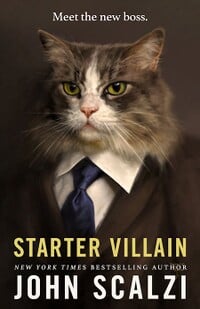
| |
| Author | John Scalzi |
| Release date | 2023 |
| Genre | science fiction |
| Pages | 272 |
| Available From | |
Welcome back, readers, to a new book review! This month, I will be reviewing Starter Villain by John Scalzi!
John Scalzi is a well-known sci-fi author with many books to his name. This is not my first John Scalzi book; my first was The Kaiju Preservation Society, which I picked up this year before watching Godzilla x Kong: The New Empire. Starter Villain came up on one of my library lists, and thinking of how much I enjoyed tKPS, I put a hold on Starter Villain. Let’s take a look at this book, shall we?
We open with our main character, Charlie Fitzer, watching a TV news segment on the death of his Uncle Jake, a bigwig in the world of parking garages. Charlie is a divorced substitute teacher living in his childhood home after his father’s death, trying not to become homeless as his siblings wish to sell the house for the inheritance money. When he comes back home from a failed attempt to secure a loan from the bank to buy a small bar in town, Charlie meets Mathilda Morrison, his uncle’s right-hand woman. Morrison informs him that his uncle’s funeral is happening in town, as Uncle Jake wanted to rest near his sister (Charlie’s mother). She asks Charlie to stand for his uncle at the funeral, and if he does, his uncle’s trust will buy his house from his siblings for a substantial amount, and then sell it back to him for a modest fee so he can keep living in it without his siblings bothering him about the inheritance. Charlie agrees, and heads to his Uncle’s funeral. One very strange funeral later, and Charlie finds out that his uncle only used his parking garage as a front for his real job: being a villain. After his death, he has pinned his hopes on Charlie to carry on his business in villainy, and Charlie is plunged headfirst into the world of real villains and the tangled web his uncle left behind when he passed.
One thing I love about John Scalzi’s writing is his protagonists. Charlie feels like a totally normal guy that you would meet at the water cooler in the morning and talk to before you start your day at work. He can be a little thick at times, but he tries his best to keep up with the massive revelation that Morrison has dropped onto his plate. To be honest, I found all of the characters in this book likeable, and by that I mean that I didn’t find any of the characters annoying. There was never a point where a character entered a scene and I went “ugh, not Joe again!” I appreciate authors not making their side (or main!) characters unlikeable and annoying, and everyone here felt quirky and memorable. Scalzi does a good job with his characters.
Something else that I think Scalzi does really well is making his books feel real to our world. Starter Villain doesn’t take place in an alternate dimension, it takes place in our world, and it feels real. The world of parking garages seems like a weird concept to me, a person with no experience in parking garages, but maybe it would feel more familiar to someone who was in the world of parking garages. Either way, the worldbuilding feels effortless and you feel as though you’re sitting there having the entire experience right there. It’s really good writing, and it’s no wonder Scalzi is so beloved. Sci-fi is a genre that can be so hit-or-miss, especially if you have four chapters of world-building to get through before the plot can get going, so setting his books in “our world but not” was a good move. It helps you to hit the ground running and keeps the story moving smoothly.
Honestly, I can’t recommend John Scalzi’s books enough to you. Starter Villain is a great starting place to get into his books, or as a great introduction to sci-fi as a whole if that’s your thing. Both books I’ve read of his have been delightful, and I’m happy to have a new author to follow. I’m looking forward to seeing what he writes next!
That’s all for me this month, readers! Check in next time for a new Graphic Novel review!
Austin - Part 3
Local food brands
Now that I’ve checked out all of the grocery stores, restaurants and food places I cared to see, wandered into quirky gas stations at 9pm, it’s time to bring it all back to the hotel and finish eating as much as I possibly can before I need to order a Lyft to the airport because we will NOT be paying the overweight baggage fee. While I definitely tried individual items from specific places, this month is (mostly) about Austin-local and adjacent brands that you can get from many different places. There are plenty of other local brands I tried (Easy Tiger, Rambler, Grackle Oil, Madhu, Mill-King, Austin Eastciders, etc.) that I just didn’t have anything interesting to say about, and I think that’s just part of the fun in exploring what different areas have to offer.
1836 Farms, Banana Milk
If you don’t know anything else at all about me, you might at least know that whenever I go somewhere different basically the first thing I do is hunt down whatever their local milk brands are and scope out what selection they have standard in grocery stores. Among these in Austin is 1836 Farms, a family farm just east of Dallas that produces organic milk along with some teas, lemonade, etc. Despite the name ‘1836’ and claims of a 100-year lineage, 1836 Farms was actually founded in 2020 by an established Danzeisen in Arizona, though I understand the critical need to pretend your company has true Texan roots in a state so rooted regional identity. While their store finder pretty much only shows them being available at every H-E-B in the area, 1836 milks felt pretty ubiquitous as I saw them in Central Market, Sprouts, and nearly every other local grocery store that had a refrigerated dairy cooler. It seems that nearly every region in the country has a dairy farm that produces milk, lemonade, and other drinks all in the same shape half-gallon and quart glass bottles, all following the same system of charging for the bottle deposit that you can receive back if you return the bottle back to the store after you’re done. I’m curious if this is a coordinated operation or just the most basic way of making a profit from this kind of farm, but I just think it’s goofy how they’re all effectively the same, perhaps ordering flavors from the same catalog but with different ethics and methods regarding their actual milk and additives–a little changes a lot. The deposit for these is a standard $2, and in my personal experience I kinda like just keeping the bottles for dry food storage, decor because I’m a weirdo, a little because I never care enough to bring them back, but mostly to hold whatever drinks I end up making at home.
The good thing is it tastes like banana-flavored milk. The bad thing is it tastes like banana-flavored milk. Less an actual banana and more that polarizing fake candy banana flavor that is most recognizable in banana Laffy Taffys. There’s emulsifiers added to give it a smoother and thicker feel that I think just lifts it over the edge towards stomach-churning. My gripe is entirely with the flavor, as it physically felt satisfying with how smooth and silky it was, excellently chill thanks to the glass bottle. I’m not sure if making it thicker like a smoothie would’ve helped because the flavor was purely fake banana with absolutely nothing holding it up, unlike Mooala Bananamilk which, for better or worse, contained cinnamon and sunflower seeds that gave it more of a banana bread taste. What I'm imagining is that this could possibly taste good in, like, cereal, or in a smoothie, maybe to make a creamy cocktail, add chocolate syrup or peanut butter powder, and the circumstances in which I purchased and had to consume it just wasn't very conducive for how it could've been used.
Volleman’s, Vanilla Milk
The other one I saw all over Austin was Volleman’s. From what I can tell, the difference between the two is 1836 has the USDA Organic certifications while Volleman’s does not, but still [https://www.vollemansdairy.com/our-story/ boasts about environmental sustainability and animal welfare and REALLY tries to show off that they’re Texan. Along with 1836, Volleman’s reaches hard to connect to the 19th century, but actually has more tangible connections to their current farm starting in 1993 and bottling milk by 2020. A key way Volleman’s has expanded is through partnering with a home delivery service that provides other brands direct to consumers, hitting nostalgic notes to win people back from alternative milks to a more classic feel or those trying to live their cottage-core fantasy, but it also helps that they’re available in every H-E-B and local grocery store in the area. Along with basic whole and 2% milk, they have a variety of flavors and also offer juice, tea, and lemonade in ways that’s absolutely not surprising with an operation like this. I do appreciate that their flavored and seasonal milks are a bit more offbeat than I see with places like this; not completely unfounded but just harder to find. Horchata sounds interesting, and I’d love to see if there’s actually any difference in taste between their Pumpkin Spice and their Eggnog.
I purchased their Texas Homemade Vanilla Milk, which has the simple ingredients of milk, sugar, natural flavor, carrageenan, and guar gum–things I fully expect in basic chocolate milk, but this time around it’s vanilla. You can go organic all you want, but there’s just something magical about that goopy slop of carrageenan and gums that make for the smoothest of milks, and being vanilla-flavored adds to that soft warm smooth feeling. It kinda strikes me as odd that people are so afraid of carrageenan and guar gum for being unnatural when they’re actually completely natural After shaking it up it holds the froth very well and becomes almost like a milkshake or an ice cream float, aided by how cold I set the hotel fridge at. Extremely indulgent in a way that reminded me of farmhouse-style ice cream shops on a late summer day, and I know that vanilla flavor can only take you there so much so at the end of the day there’s just a good quality delicious milk keeping the bar high. I feel that this would be great making it into a tipsy drink, mixing it with coke or root beer, made into something like a Thai iced tea, mixing the 1836 banana milk with this would’ve been a great idea but it is about 6 months late to try that; an idea to hold onto moving forward.
Rebel Cheese
The first time I tried vegan cheese was in 2019 at an excruciatingly expensive bagel shop in downtown Orlando, and my initial thoughts on it were that it’s absolutely atrocious, nothing like cheese at all in terms of flavor, texture, and general material physics, and that the copious amount of seasoning used was very obviously an attempt to hide the fact that it tastes like trash. As time has quickly passed, innovations in fake cheese tech has turned a weird and gross idea into a normalized alternative that takes up considerable shelf space in most grocery stores. A Shark Tank alumnus, Rebel Cheese is a plant-based vegan cheese producer whose products can be found used in restaurants and food establishments around the country, as well as in a few select grocery stores (particularly Erewhon of southern California. Luckily for me, their main setup and bistro is within walking distance of the Texas Farmers’ Market at Mueller.
I went here on the market day as did apparently the rest of the state of Texas, which made ordering any (all vegan) sandwiches or salads seem like a horrible idea, especially as the bistro area inside was a meager two or three tiny tables crammed in a corner while any and all outdoor seating was completely taken, but a separate line for their cheese case was something I was absolutely going to wait in. Customers have the privilege of sampling as many of the options as they want, which the lady in front of me took extreme advantage of, likely intaking over a hundred dollars worth of product before getting a sliver of something for under $10; she absolutely won the sample game here, but at the cost of thousands of years in bad karma as everyone behind her plus the worker had to suffer through her not even knowing what cheeses the vegan options were replicating. This setup, though, made it possible for me to take some back to the hotel, along with instructions on taking it home. It’s also important to note that Rebel Cheese has a nice little grocery wall, with a fair collection of cheese-adjacent charcuterie and snacking items that any other respectable cheese establishment would carry such as jams, spreads, crisps, chips, chocolates, dried fruits, wine, teas, kombucha–all of it high-end expensive luxury items, of course. Unfortunately it was hard to actually access this wall as tables were nearly flush against it, requiring me to rub up against some idiot who decided that sitting inches away from an unorganized winding queue was a great idea. I will say that the whole place had a cool and chic vibe, definitely warranted the attention it was getting, and I genuinely did not know this was a Shark Tank-funded place until I did online research as they didn’t plaster it on every door and window like other places do when their product can’t sell itself.
While initially cynical about the whole thing, as soon as I was able to see the display I was quickly mesmerized by how realistic they all look, the artistry and care put in to have each faux cheese look identical to their real counterpart in ways completely flawless if not for how ultimately these are all just damp mounds of cashew pulp that deform like soft clay with the press of your thumb. Brie, muenster, smoked cheddar, goat, all made possible because the ingredients appear to utilize bacteria, enzymes, and aging processes that each actual cheese would use and is just replacing the milk with tl;dr cashews and fava bean protein. I had my fair amount of samples, including Barn Cat (their Humboldt Fog mimic), Asheville Cheddar, Muenster, and my critique for them is all the same: remarkably accurate flavors, but remarkably vile texture. This problem can be mitigated if the samples are tiny, or if the fake cheese is being used on a sandwich with plenty of other textures going on, but if you get a good enough piece of any of them they all just have that same extremely dry chalkiness to them that makes me question the sanity of everyone in every other comment section in Rebel Cheese’s atmosphere saying that these are perfect replicas and are unable to tell the difference. Don’t get me wrong, for the ones with washed rinds and skins they definitely had the beginnings of feeling similar, and that’s because it’s similar bacteria and mold compounds from what I understand, along with following similar artisanal cheesemaking techniques like cave aging, or were pumped full of rice flour to firm them up like with the fake cheddars. As a result, the ones I found most successful were the faux-goats and faux-fromages as with those the vegan cheeses essentially being flavored nut spreads didn’t really make much of a difference. What I settled on bringing home was the Triple Peppercorn Chèvre, as it was one of the ones listed as being suitable for freezing for intended travel, but by the time I got it home it appeared to have begun separating and bleeding out the oil, leaving it feeling very dry and a bit gritty while being simultaneously bland with sudden shots of sourness. I had it frozen solid at my hotel, kept it in an insulated bag, and got it home and into my fridge with the packaging still physically cold, so I’m confident that temperature-related spoilage was at play here. The fact that their fake brie is unable to melt and is meant to be served cold is indicative of the qualities lacking in what’s been referred to as one of the more successful vegan cheese mimics to date. Ultimately, what I think Rebel Cheese actually does best is recreate the gourmet full-service cheese case experience, adding tactile warmth to a product category that so far has been either kinda hokey or scientific, but perhaps some things just can’t be fully mimicked. I guess you’ll just never fully appreciate a good brie until you try see what it’s like without a soul.
Meridian Hive, Blackberry
Another thing I check out, perhaps not with as much excitement and fervor as weird milk, but nevertheless with interest is local ciders and meads. Alcoholic ciders and meads don’t seem to get as much love as IPAs and whiskeys, significantly less shelf space if even stocked at all more than just the token shelf, which is sad because those are basically the only ones I like as they tend to be a bit sweeter and hide the fermented taste a bit more. It’s not really any deeper for me than being one of the first things I do when staying at a hotel for several days to do some basic snack shopping and stock up on some tasty fizzy drinks that make me feel comfortably woozy and smiley when I get back later at night.
Among the like seven or so woozy drinks I bought was Meridian Hive’s Blackberry, a lightly carbonated wine cocktail with blackberries, using orange blossom honey; in fact just water, honey, and blackberry concentrate are the only three ingredients. The website indicates that this is made with honey, if the name being Meridian Hive didn't already allude to that, and refers to it as ‘hard honey' in just a couple spots. I'm sorta confused why they're completely avoiding calling this a mead when it very clearly is, and digging deeper hints a little towards Meridian Hive positioning their company to be modernizing mead, and turning it from a niche specialty only a bunch of history nerds care about into beverage that has more broad appeal, so perhaps avoiding saying ‘mead’ and instead saying ‘wine’ and ‘adult juice’ will get Austin’s clean-cut liberals to partake in something that typically has unsavory connections to viking iconography. At $3.99 a can it’s more expensive than other singles around it, and with mead requiring a higher cost of production it makes sense to me, but perhaps marketing it in a way that appeals to a larger swathe of the local population that also actually has money to spend on a luxury leisure product just seems smart.
Meridian Hive states that the Blackberry flavor is their bestseller, which makes me happy for blackberry flavor as a concept because it's easily one of my most favorite things. Right away I knew something was off, because I didn’t get that first-sip repulsion I usually get when having any other IPA or cider. Couldn’t tell it was alcoholic at all, but more sweet and fruity, with just a touch of tartness. The flavor was minimal and light, but accurate and tasty in a way that leaned more refreshing than something you’d chug to get woozy. Their store locator button is currently linked incorrectly and not working, but luckily Total Wine’s is and tells me that the closest in-store availability to me is over 200 miles away in Jacksonville, which is sad because ordering from their website to have it shipped requires a minimum purchase of 12 cans which costs $34.50 itself plus a minimum $19 delivery charge that makes it rather prohibitive. Should you want something that’s not as light and crowd-friendly as this, Meridian Hive does make stronger meads that are more akin to what more avid drinkers and enthusiasts are used to, though they are limited run which is a trend in drinks that I think is vile.
Yeah, Meridian Hive has a horse in the race in regards to keeping bees alive, but they do seem particularly active and direct about conservation. They’re involved in the community and active with local events both small and large, bringing mead back into the fray as an option besides just beer and wine. I also appreciate their creativity with flavors, despite the limited and simple ingredients, both because it shows what’s possible without manufacturing extracts and compounds, but also because it’s fun! Never NEVER would I say that artificial flavors are bad by default, but seeing that there can be delicious foods made without it feels almost inspiring, triggering ideas of what I could do, and that’s just cool and good.
Lammes Candies
As soon as you fly into Texas you’ll see right away every shop selling unassuming boxes and collections of chocolate and pralines. A staple in every setup of local Texas foods and gifts is Lammes Candies. Founded in 1885, primarily serving ice cream, Lammes Candies shifted the focus to chocolates in the 1960s, and has served Austin for holidays and otherwise reliably since then. Keeping tradition strong and supporting local spirit, Lammes continues to make their best-selling pralines with only Texas-grown pecans. A fantastic article in Edible Austin goes on to give more history of Lammes, detailing how core they are to Austin’s history and community, and I believe is required reading to get more of the folklore.
The Airport Boulevard location, which is their flagship spot with outposts elsewhere, looks a bit sad, but that’s more of an issue of the surrounding area being a bit gray and desolate. I felt kinda bad for it, that it seems like they hardly get any foot traffic aside from maybe the county clerk’s office in what’s supposed to be their main location, but I suppose that’s why they have locations in a mall and other shopping outlets to capture those customer bases. I will say that their Airport Blvd location did make it convenient to the Mueller area, Hyde Park, quick access from downtown and several highways; I guess a more strategic and central location may not itself be a visually good area but one that can be walked to by several otherwise clustered communities.
The store itself had the full selection of products, along with a traditional full-service chocolate counter where you can get all kinds of chocolates, candies, clusters, dipped fruits, barks, caramels that holds strong a kind of business I’ve tragically seen falling out of style. At the time I went it was staffed by two incredibly nice and knowledgeable peeps, which kinda put my guard up because it’s always really awkward being the only person shopping in a small store where the workers have nothing else going on other than watching you walk around, but they were very respectful and made themselves available if I had questions but otherwise doing nonsense busywork and left me alone. I made sure to get some peanut clusters and peanut butter squares to boost my sales total up to something I felt was respectful for the work put in and time I spent here.
Texas Chewie Pecan Pralines
Their best seller and one of their oldest recipes, Texas Chewies are made with five (six?) core ingredients: pecans, corn syrup, sugar, milk, butter, and salt. While their own website does not list all of the ingredients, other sites and boxes of course do, which includes added colors, flavors, and emulsifiers that I personally don’t care about but I’m absolutely sure their local Austin base exponentially will. The box I got was $4 for 2 oz, containing two individually-wrapped pieces. I appreciate the wrapping as the caramel posed a risk for getting melty and sticky, but I never came across this issue despite traveling with them in both Texan and Floridian heat and humidity and was able to unwrap each one without issue, which is an experience that way too many candy manufacturers ignore. Very heavy on the pecans, and definitely chewy, they maintained a level of fresh taste that I guess I did not expect but really should have. I actually really liked how the caramel stayed mellow and creamy, like a sticky fudge with noticeable buttery taste, without a sharpness to the salt that I’d get from more commercial caramel/nut combinations. I never got bored of eating it, and my jaw never felt sore at any point, and I think two of them was the right amount.Longhorns
Similar to Turtles, Lammes’ Longhorns are ‘pecans and caramel in rich chocolate’, using milk chocolate, and are also available with white and dark chocolate. Only two pieces in the 1.5 oz box for $4, which is both surprising in the way of it not just being one piece, but expected that it would be $4 for two pieces of chocolate at a local family-owned place like this. With an operation as widespread as they have, fully integrated into Texan airports as a must-buy gift, I’d assume they have enough gross profit to nudge their prices a little lower, but I’m not gonna gripe about that too much and more hold it as an expression of curiosity in reviewing their P&L statements.
Looking into more of their products makes it seem like they’re a one-trick pony, and I guess in a way, but Lammes goes on to explain the subtle difference between Longhorns and simply chocolate-covered pralines: “Our Longhorns are made in layers: layer of pecans, layer of caramel and fully enrobed in chocolate. Chocolate covered pralines are made with caramel and pecans cooked together, then enrobed in chocolate. This leads to a difference in texture and bite. If you are seeking a more chewy texture, we'd recommend our chocolate covered pralines!” While I didn’t try the chocolate-covered pralines, comparing the gummy chewiness of the Texas Chewie Pecan Pralines to the Longhorns that lean more Snickers-esque. The pecans, not being cooked with the caramel, remained a bit more firm and dry, providing a satisfying contrast to the creaminess the caramel provided. They promise to not stick to your teeth, and I can confirm that they only did a little bit. With these not having as much caramel as the pralines they were a lot less chewy and were faster to eat, but still heavier on chewing than I expected from something so simple. I’m not sure if two actually seems like a fair amount, but with how rich and dense they were coupled with using
While I can’t say I’m blown away by the ones I tried, I’m comfortable in saying that I didn’t need to be. They’re a cute local candymaker that’s been around for basically forever and we all need to cherish these kinds of places and give them whatever support possible as they genuinely do function as a backbone of local culture in ways you’ll never realize until you move away from an area with something like that. Next time I come across any of their stuff, I’d be curious to try their Habanero Pralines and Choc’Adillos.
Imperfekt Bites
Imperfekt started in Austin with the idea that wholesomeness and decadence are not mutually exclusive, using high quality ingredients and Fair Trade chocolate to make less of a treat and more of a hearty snack. Imperfekt actually specifies that they have a higher percentage of inclusions than they do chocolate, making it more like bags of curated trail mixes that have melted together rather than a chocolate dessert. Hand-crafted, gluten free, full of antioxidants and protein and energy boosters, ‘thoughtful indulgence’ is the pendulum mid-swing back towards sugary sweets that people abandoned for healthy foods that they can no longer stomach and I’m hoping it stays here for a while.
The two flavors I chose were Texas Twist and Go Bananas, because I simply had to get the Texas-themed one and the bananas seemed like the only one I might possibly find worth the price. Texas Twists are dark chocolate clusters with Texas pecans, mango, and arbol chili powder, while the Go Bananas are dark chocolate clusters with banana chips, cashews, and blueberries. The reason I’m not otherwise splitting this off now into two sections to review each flavor is because my commentary on each is the same–hardly any flavor beyond somewhat sweetened dark chocolate, with primarily the textural qualities coming through. Individual characteristics of these inclusions shape them, for example with the banana chips and cashews of the Go Bananas providing a noticeable crispy crunch, while the pecans and mangoes of the Texas Twist having a relatively softer bite. Despite hardly any flavors coming through, they both taste good and adequate, balanced between sweet, salty, and bitter, and still lean in particular admitted LaCroix-esque ways of subtlety. I was a little upset after buying these for $6.99 at Royal Blue Grocery (with their Hey Hey Hazelnut flavor being marked as $10.25???) only to walk into an H-E-B shortly after and see them all on sale for like $5, but that’s more of an issue with retailers. The recommended servings per container being 4 feels appropriate, as that’s about how many times I dug into each bag to finish them off with a total of about 15-20 clusters of slightly varying size per bag, but 35¢-50¢ for each little cluster still leans a little into excessive luxury pricing. I feel like the chocolate could be more stable, as it melts easily in my hands in a 77F air-conditioned room, though I’m sure that’s a consequence of them simplifying the ingredients towards things more direct and free from processing implications that scare people who don’t know what words mean.
My unsolicited advice to the Clasen Candy company is to diversify the sizes by making smaller lunch-friendly packs of maybe 4 or 5 clusters for a higher net profit of maybe $2.50, increasing the size of the basic $6-something bag from 4.2 oz to a hearty 5.4 while maintaining the price, and then get a deal with Costco for national distribution for enormous 16 oz bags for $15 or family packs of smaller versions to rake in that sweet delicious gross profit to support sustained business for what could be the ticket to an attempted buyout from PepsiCo that you’ll reject to solidify the rebellious small business cred, all so I can buy some locally every now and then.| The 'Shroom: Issue 210 | |
|---|---|
| Staff sections | Staff Notes • The 'Shroom Spotlight • Poochy's Picks • Credits |
| Features | Fake News • Fun Stuff • Palette Swap • Pipe Plaza • Critic Corner • Strategy Wing |
| Specials | TV Tomorrow Commentary Tracks |
